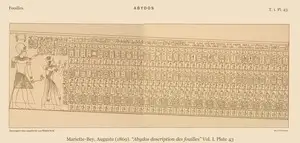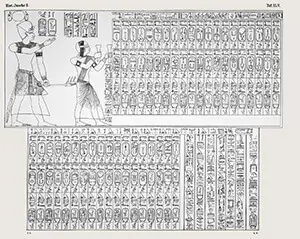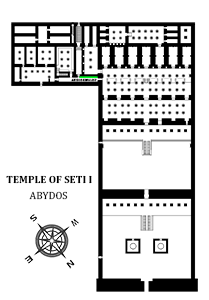The Abydos Canon, also known as the Abydos Table or Abydos king list is a list with the names of 76 pharaohs of Ancient Egypt.
It is still in place on a wall in the Mortuary Temple of Seti I at Abydos in Egypt. The Temple was discovered buried in sand and excavation began in 1859 under Auguste Mariette. Unfortunately, many of the reliefs were badly damaged by Islamic iconoclasts hacking off the faces of the kings around 1890.
The king list was part of a ritual where the spirits of the ancestors were invoked. The names on the list celebrated and memorialized "ancestors" of Seti I, and was not meant to be a historically correct chronological list. It shows only pharaohs that were selected as worthy of admiration and respect. Queen Hatshepsut and the Amarna period pharaohs were not included, nor any from the Second Intermediate Period.

The inscribed list of kings is found in the Mortuary Temple of Seti I, on the right wall of the passage coming from the second Hypostyle Hall, referred to as the Gallery of Lists. Seti I is on the left wearing the blue crown, holding a censor in one hand and gesturing towards the right with the other. In front of him, young prince Ramesses is shown holding a papyrus to read from with an accompanying text before him:
Reciting praises by the hereditary prince; the eldest of his body, his beloved (son), Ramesses, justified, true of voice.
The text runs in six vertical columns above Ramesses, and is the speech given by Seti I:
Words spoken by King Menmaatra. Bringing the god to his food offering, the making of offerings for the kings of Upper and Lower Egypt. Greetings to thee, Ptah Sokar, who is South-of-His Wall. Come, that I may make for thee these (things) which Horus made for his father Osiris.
The first fifty-six names shows an orderly progression of legitime rulers of Memphis. The kings who are not included are those whose rule over the Two Lands is questionable, or, who had some measure of political/religious bias towards them, like for example, not ruling from Memphis.

Content of the list
The list consists of three rows of thirty-eight cartouches on each row. The upper two rows contain names of the ancestral kings, while the third row repeats Seti I’s throne- and birth-names. In all, seventy-six kings are mentioned. The hieroglyphics are read from left to right, the upper row is read before the lower. The cartouches of the kings are preceded by the words n nisu, which translates as "To king.....". The third row with Seti’s names is preceded by "By the gift of.....".
Loved by Re, <small>[lacuna]</small> is his protection
The perfect one of the ka of Ra, who belongs to his lord
The enduring one of the ka of Ra, the foreigner
The perfect one of the ka of Ra, the wanderer
The perfect one of the ka of Ra, the respected one
The perfect one of the ka of Ra, Pepi is healthy
The perfect one of the ka of Min, the beautiful one
The perfect one is the one whom the ka of Ra has made
Holy are of the manifestations of Ra, chosen of Ra
Gallery
A small collection of drawings featuring the Abydos Canon
Bibliography
- Mariette, Auguste., 1869. Abydos description des fouilles, I. Paris: plate 43
- Dümichen, Johannes., 1869. Historische inschriften altägyptischer Denkmäler, Vol II. Leipzig: plate XLV
- Kitchen, Kenneth A., 1975. Ramesside Inscriptions, I. Oxford: 176-179, §77.
- Kitchen, Kenneth A., 1993. Ramesside Inscriptions. Translated and Annotated., Vol. 1. Oxford: 152-56.
- Kitchen, Kenneth A., 1993. Ramesside Inscriptions. Translated and Annotated: Notes and Comments., Vol. 1. Oxford: 117-25.
- Porter and Moss., 1991. The Topographical Bibliography, VI. Oxford: 25 (229-230).
- Frankfort, H., de Buck, A., & Gunn, B., 1933. The Cenotaph of Seti I at Abydos, 2 Volumes. London.
- Redford, D. B., 1986. Pharaonic King Lists, Annals and Day Books. Mississauga.
- 360 degree view of the list, courtesy of 360cities.net



